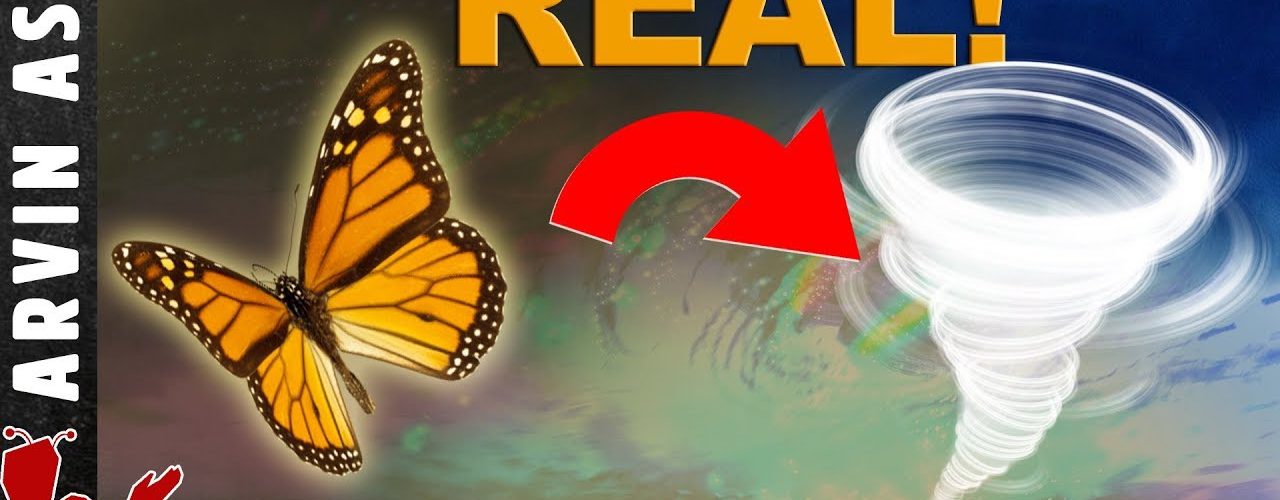The Real Butterfly Effect — Imagine this scenario, a butterfly flutters its wings in Brazil, and it sets off a cascade of events over the course of time, which results in the touchdown of a tornado in Texas.
This is the idea that lots of seemingly small chaotic differences in initial conditions can make a big difference over time and distance. Is this effect real? And if so, how does it work? Let’s look at this more closely.
In 1972, meteorology professorEdward Lorenz asked the question at a conference: “Does the flap of a butterfly’s wings in Brazil set off a tornado in Texas?” This was really just a rhetorical question.
Lorenz was trying to point out that large meteorological phenomenon, like tornadoes or hurricanes cannot be predicted far in advance, because there are too many small variables which are beyond our capability to measure. This is why tomorrow’s weather forecasts is much more accurate than a 10 day forecast. There are too many variables that can change over 10 days, whereas there are fewer variables that change in 1 day. In other words, Lorenz was trying to say that weather is unpredictable.
He said this to illustrate the idea that some complex and dynamic systems have behaviors such that a small variance in the initial conditions could have a huge effect on the results. This idea in mathematics is part of the so called chaos theory – Meaning we don’t have a way to predict things even if we know all the variables. At least not yet.
The butterfly in Brazil making a tornado in Texas is a dramatic way to illustrate this. Or is it?
— just for fun, let’s just see how that might work, if it was really possible. Let’s make it as realistic as possible.
Instead of Brazil, picture a swarm of monarch butterflies that are migrating from Eastern Canada to Mexico for the winter. This by the way actually happens every year before the onset of winter. Tens of thousands of monarch butterflies do this as a group every year. During one of these migrations, thousands of monarchs stop in Nebraska. They might sit on a single tree at night to rest before the next day’s journey.
Again, this actually happens.
They only travel in the morning. And they sometimes wait for a large wind to help them fly. One morning, a flock of Robbins, arch enemies of butterflies happens to be flying overhead. They are also migrating south for the winter, flying from Vancouver, Canada to Guatemala.
They normally don’t cross paths, but because of climate change, the timing of their migrations happen to coincide this year. And a smaller group of Robbins gets separated from the main group flying further east than normal – right in the way of the butterfly swarm’s path. A smack of a Robin’s bird poop hits on a branch and startles one butterfly. This butterfly suddenly flaps its wings and abandons the tree in panic.
The massive fluttering of wings from multiple swarms causes a local wind perturbance. The simultaneous flutter of these swarms of butterflies adds local kinetic energy into the flow of wind in the area. This lowers the local atmospheric pressure slightly.
The slight change in pressure at the ground level causes fast moving colder upper atmospheric winds to be “sucked” into the lower atmosphere, which lowers the temperature locally by 2 degrees Celsius.
A similar effect due to wind turbines has been scientifically shown to have such an effect. So there you have how the flutter of one butterfly could, with only a slight stretch of the imagination,cause a tornado in Texas.
Now, what if by watching this video, you were late going grocery shopping by 30 seconds, thereby avoiding a guy who ran a red light that would have otherwise t-boned your car.
I just saved your life – I think you should thank me.
Citations:







